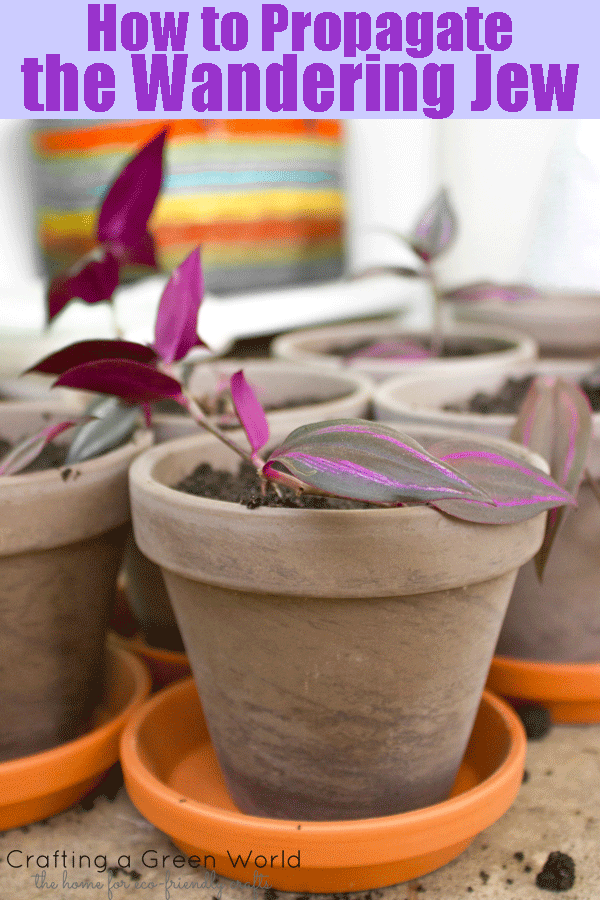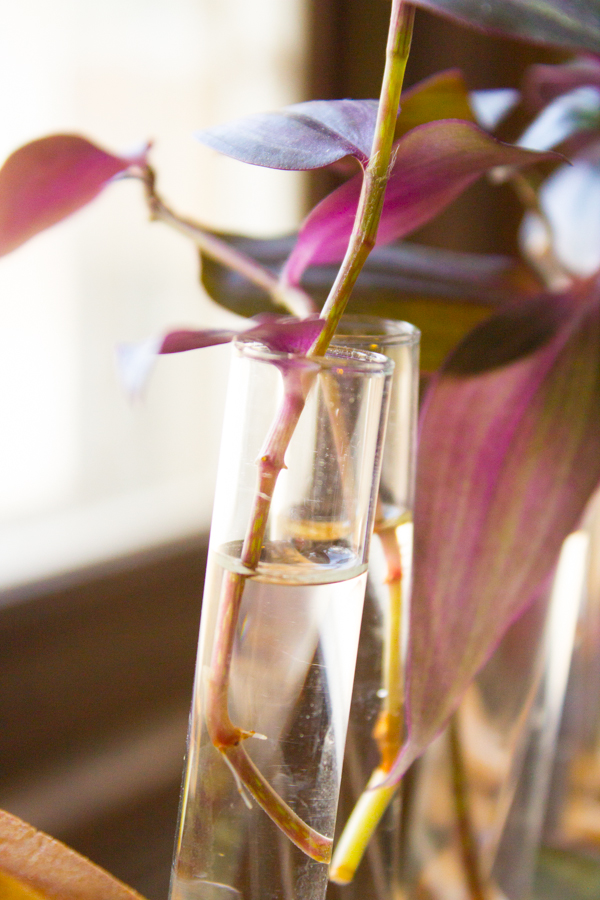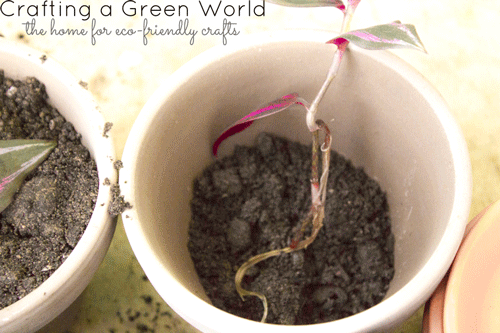This tutorial is part of Garden Week here at Crafting a Green World. We’ve teamed up with some of our favorite DIY bloggers to talk about all things gardening! Gardening can be scary if you don’t think that you have a green thumb. Why waste your money on expensive potting soil and plant starts, if you don’t think they’ll grow? Why spend a bunch of time weeding and watering, only to be disappointed? If you’re new at gardening, the plant for you is the inch plant. It’s in the spiderwort family, so it’s a great houseplant–easy to care for, attractive, and kind of dangly when it’s grown a lot, so that you can set it in a hanging planter or let it trail off the edge of a bookshelf. My favorite thing about the inch plant, however, is that it’s crazy easy to propagate. Not only does this make for an excellent kid’s gardening project, but, unlike much of life, it lets you get more plants for practically free! If you’ve got a grown-up inch plant, some extra pots, and good potting soil, then you’ve got yourself another six to a dozen inch plants right there for the taking. Here’s how:
- Prepare a temporary water home for the inch plant cuttings. Propagating the inch plant is a two-step process that’s separated by several days; this is a bonus, because it means that each step takes just minutes. First, you’ll want to put the cuttings in water until they grow roots, so prepare this water hotel for the cuttings now. Because this particular transplanting activity was also a science project for my kids, we got out our test tube rack and test tubes, and filled them mostly full of tap water. But if you don’t have a bunch of test tubes lying around–and that’s probably the more normal way to live your life–then you can use any sort of narrow container whatsoever. Shot glasses? Jelly jars? Vases? Kid-sized cups? They all make great temporary homes for your inch plant cuttings.
- Make cuttings from the inch plant. Grab a sharp pair of scissors, and begin to hack up your beloved inch plant. Now, do not make this harder than it needs to be. All the important people will tell you to sterilize your scissors, and cut at a certain angle, and cut exactly at this or that certain place, and cut exactly this or that certain amount. You can do all this, absolutely, but if you did all that, you’d have a green thumb. And you don’t have a green thumb, do you? The way that I’ve propagated my inch plants for years isn’t the “best” way, but it works perfectly for me. I use scissors–any old scissors–and cut my inch plant just above a leaf, so that I don’t leave the plant with a random stem sticking out above its highest leaf. Then I clip the lowest set of leaves off of the cutting, so that the cutting will have a node from which to grow new roots. I put the cuttings in water, making sure that any nodes that I want roots to sprout from are covered, but that any leaves that I want to not rot and die are not covered. Then I set everything in a sunny window and leave it alone.
- Watch the plant root right before your eyes. Keep an eye on the plant once a day or so, topping up the water whenever it needs it. This is another great chore to hand off to the kids–they can keep a journal of updates about the cuttings, especially because one day, they’re going to be able to write in that journal that their cuttings are starting to grow roots!
- Transplant the cuttings into pots. Any day after all the cuttings have roots, but before the roots get giant and unwieldy, find a nice few minutes to set out little pots, and potting soil. Fill each pot about halfway full of potting soil (get a really good kind!), then pick up a cutting stand it up gently in the pot, and scoop more soil in all around it until the cutting looks happy and settled. Water it well, and put it back in another sunny window, where you’ll water it as needed and watch it grow. Don’t actually need six to a dozen more inch plants? My kids and I tend to give away all of our propagated inch plants in the few months after we’ve transplanted them. There’s always a special kid who my kids think would quite like an inch plant for their birthday instead of one more toy, always a housewarming or dinner party or get-together at which an inch plant is even more welcome than a sixteenth gifted bottle of wine, always a graduating senior who’s definitely not going to get cash from me, but is going to get something nice to set on their dorm room windowsill. And when all the transplanted inch plants have finally gone away, well, there’s always another inch plant to propagate!


